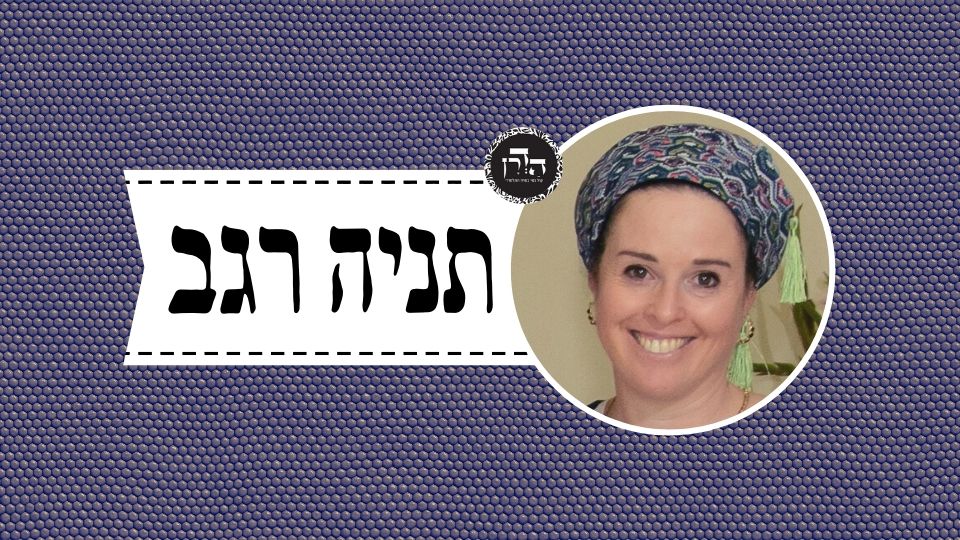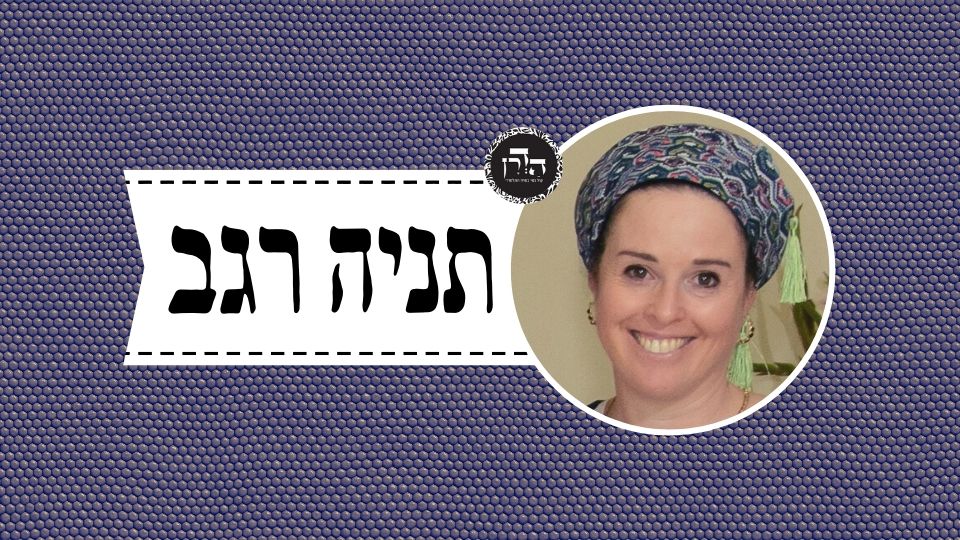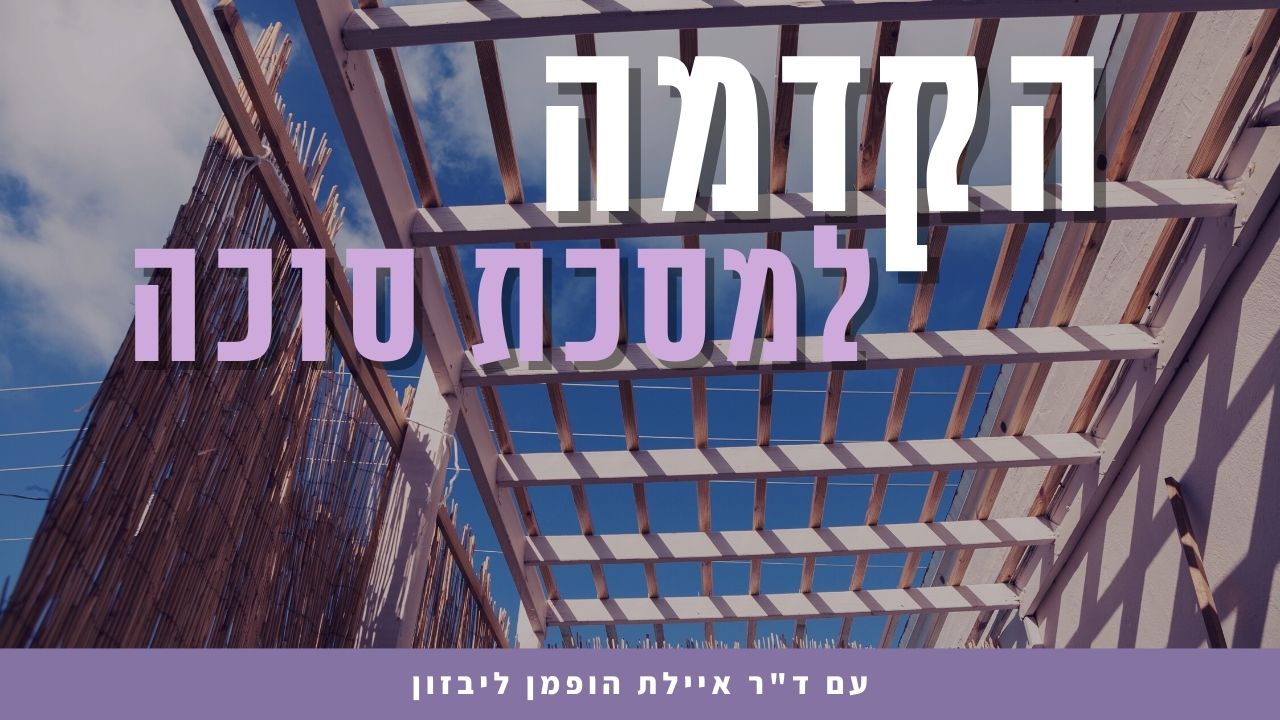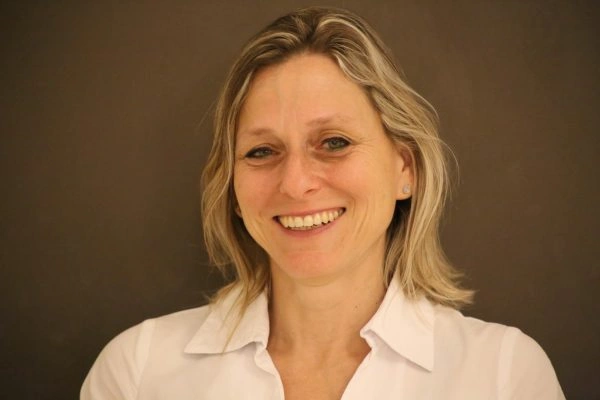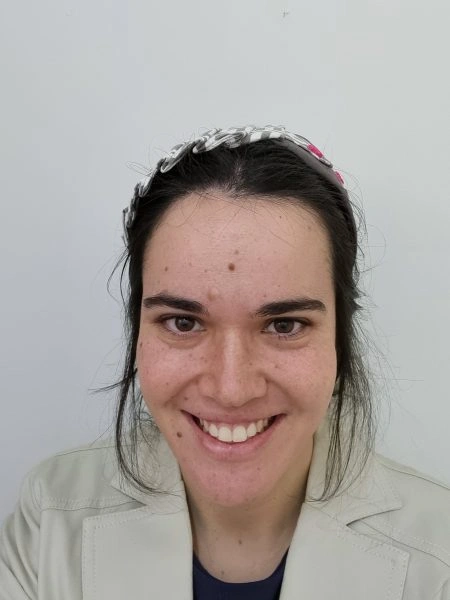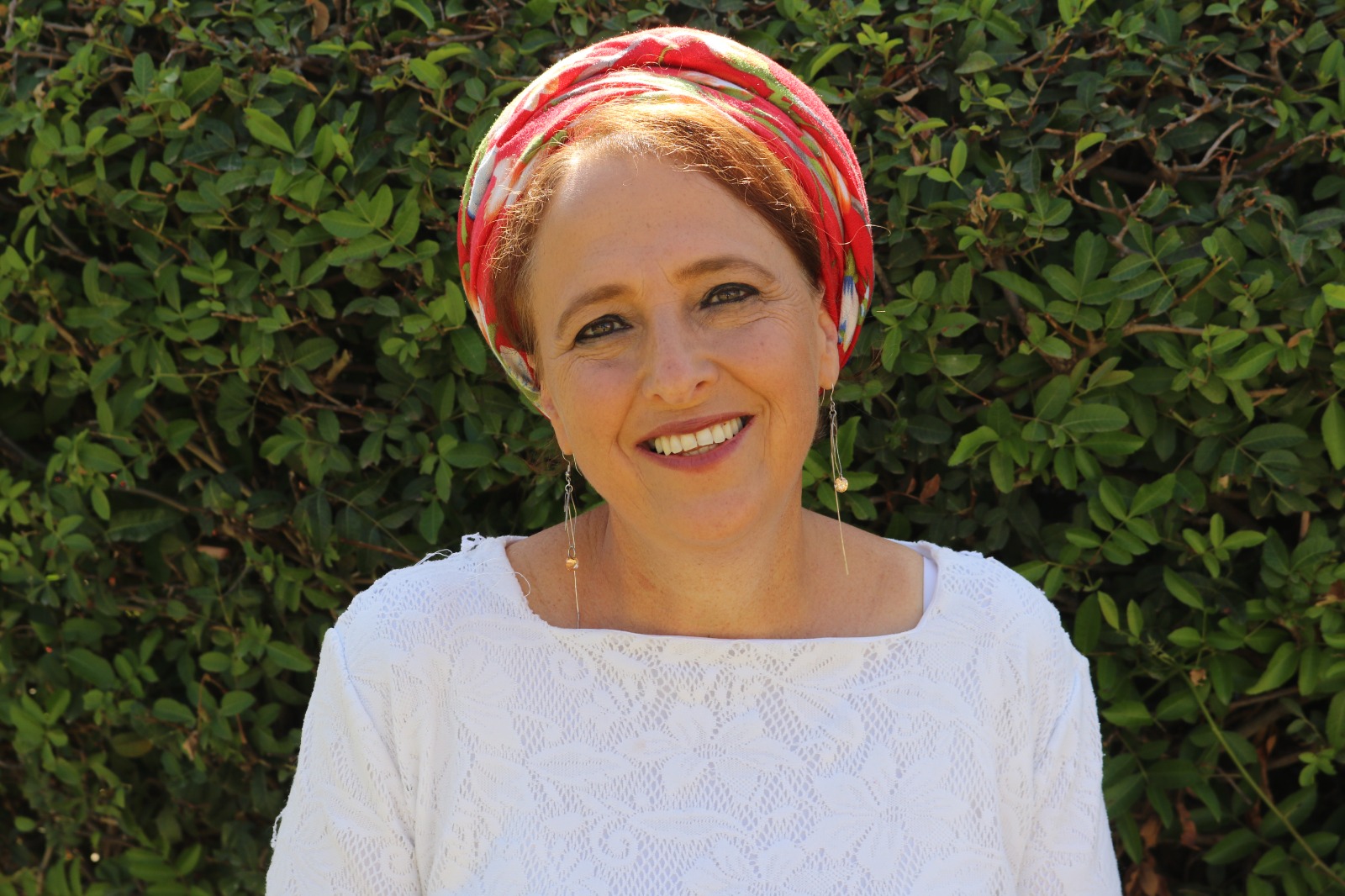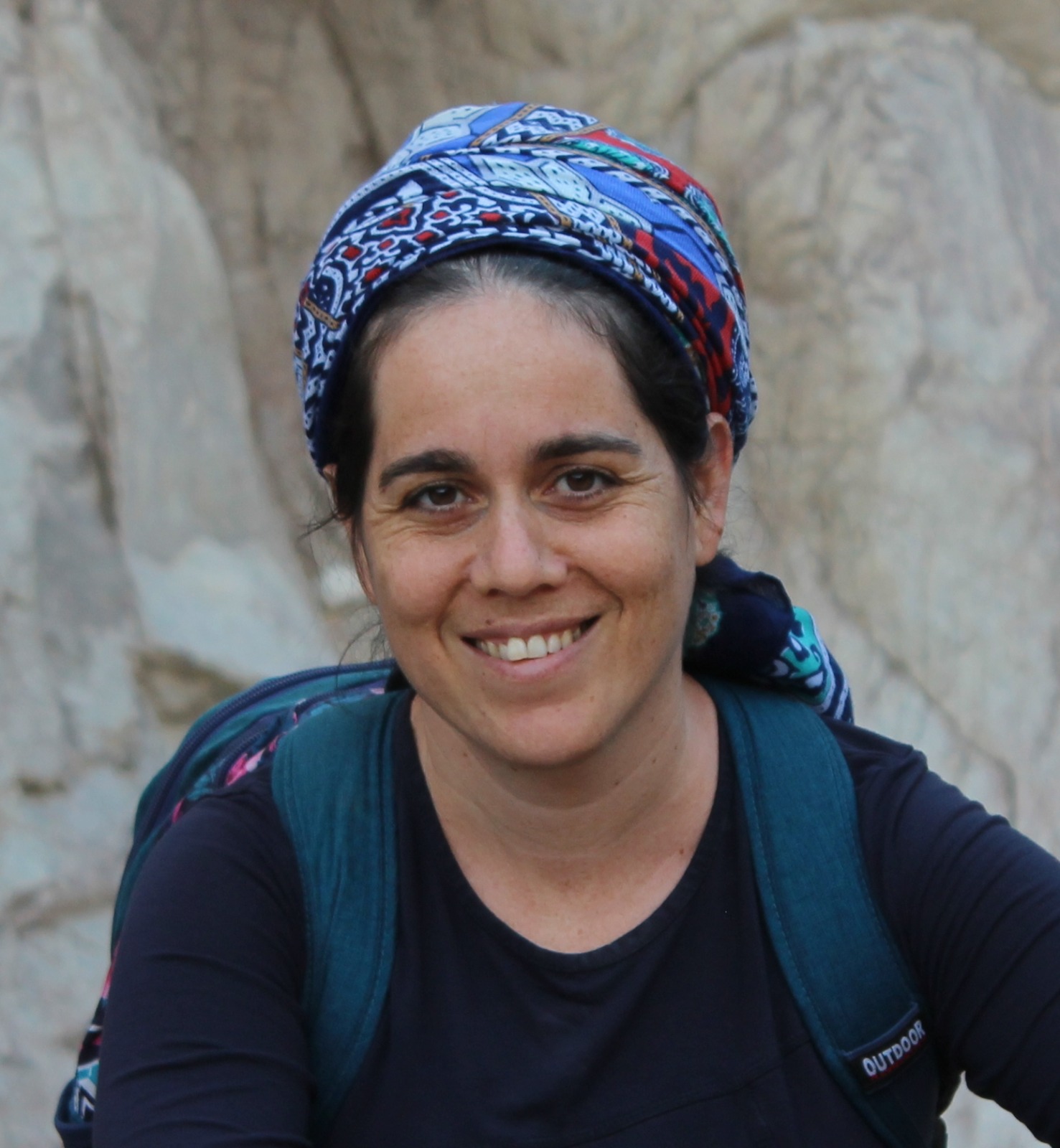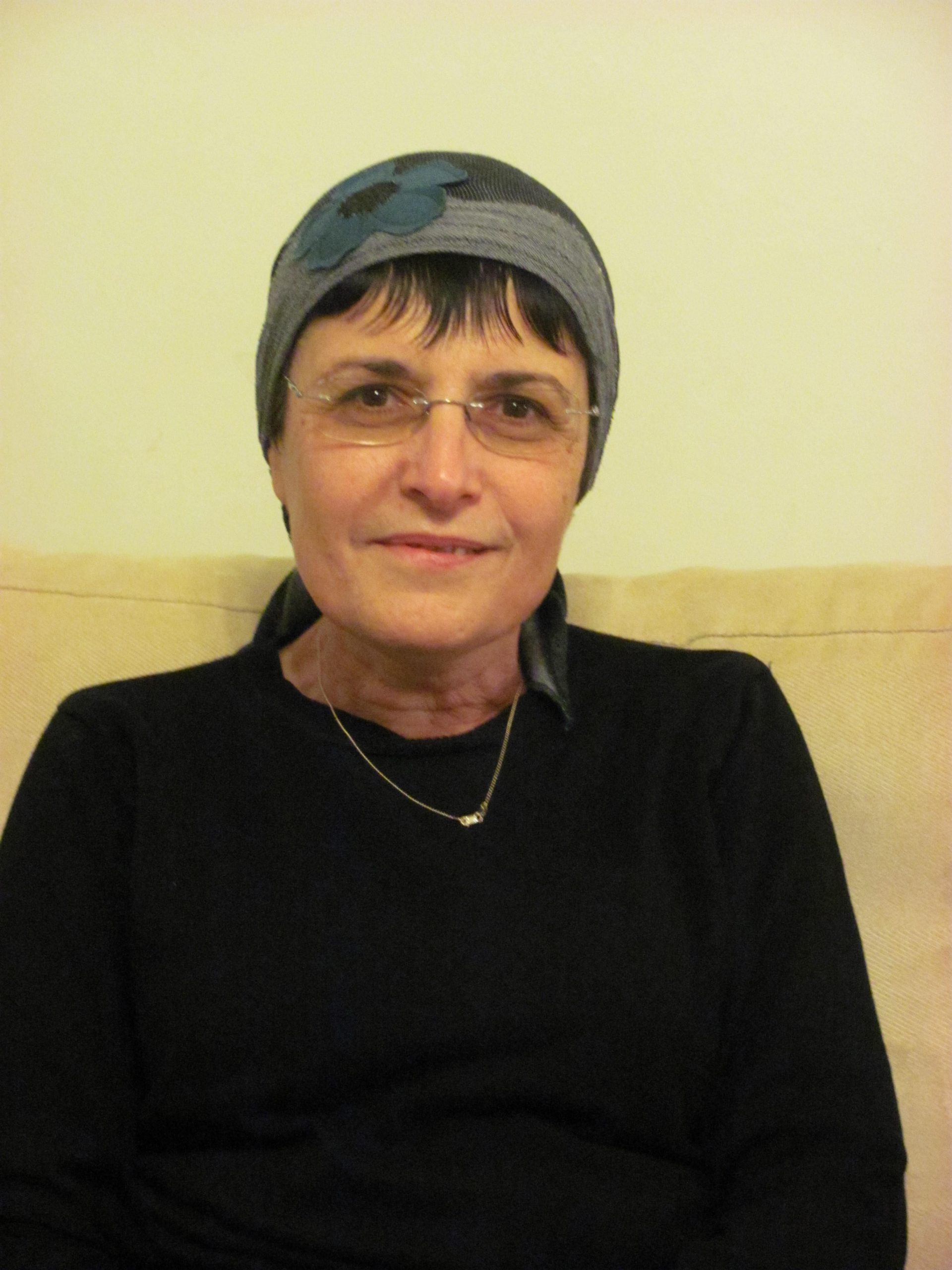מה רצה ר’ ירמיה לחדש בהבאת כל המקרים השונים של סוכה על גבי סוכה? כדי שייחשב סוכה על גבי סוכה, איזה גובה נדרשת לסוכה העליונה? הגמרא מביאה שלוש שיטות שונות ומקשה על שיטת שמואל. האם אפשר לפרוס סדין על גבי או מתחת לסכך? במה זה תלוי?

תקציר
כלים
הלימוד השבוע מוקדש ע”י רוברט ופאולה כהן לע”נ יוסף בן משה הכהן ז”ל. יוסף היה חזן שאהב מאוד לשיר, עבד קשה בחייו והיה מאוד מסור למשפחתו ולקהילה.
כלים
העמקה
רוצה להבין מה באמת קורה מתחת לפני השטח של הסוגיה?
שיעורים, פודקאסטים והרחבות של מיטב המורות שלנו יפתחו לך עוד זוויות וכיווני חשיבה.
חדשה בלימוד הגמרא?
זה הדף הראשון שלך? איזו התרגשות עצומה! יש לנו בדיוק את התכנים והכלים שיעזרו לך לעשות את הצעדים הראשונים ללמידה בקצב וברמה שלך, כך תוכלי להרגיש בנוח גם בתוך הסוגיות המורכבות ומאתגרות.
פסיפס הלומדות שלנו
גלי את קהילת הלומדות שלנו, מגוון נשים, רקעים וסיפורים. כולן חלק מתנועה ומסע מרגש ועוצמתי.
סוכה י
הֵיכִי דָּמֵי? כְּגוֹן שֶׁהַתַּחְתּוֹנָה צִלָּתָהּ מְרוּבָּה מֵחַמָּתָהּ, וְעֶלְיוֹנָה חֲמָתָהּ מְרוּבָּה מִצִּלָּתָהּ, וְקָיְימִי תַּרְוַיְיהוּ בְּתוֹךְ עֶשְׂרִים.
What are the circumstances? It is in a case where in the lower sukka, its shade is greater than its sunlight, rendering the sukka fit, and in the upper sukka, its sunlight is greater than its shade and it is therefore insignificant, and the roofing of both is within twenty cubits of the ground.
וּפְעָמִים שֶׁהָעֶלְיוֹנָה כְּשֵׁרָה וְתַחְתּוֹנָה פְּסוּלָה הֵיכִי דָּמֵי? כְּגוֹן דְּתַרְוַיְיהוּ צִלָּתָן מְרוּבָּה מֵחֲמָתָן, וְקָיְימָא עֶלְיוֹנָה בְּתוֹךְ עֶשְׂרִים.
And there are times when the upper sukka is fit and the lower sukka is unfit. What are the circumstances? It is in a case where in both sukkot their shade is greater than their sunlight, and the roofing of the upper sukka is within twenty cubits of the roofing of the lower one. In this case the upper sukka is fit, while the lower sukka is a sukka beneath a sukka and is unfit.
פְּשִׁיטָא! תַּחְתּוֹנָה כְּשֵׁרָה וְעֶלְיוֹנָה פְּסוּלָה אִיצְטְרִיכָא לֵיהּ. מַהוּ דְּתֵימָא: נִיגְזַר דִּילְמָא מִצְטָרֵף סְכָךְ פָּסוּל בַּהֲדֵי סְכָךְ כָּשֵׁר, קָא מַשְׁמַע לַן.
The Gemara asks: This is obvious. There is nothing novel in any of these scenarios. The Gemara answers: It was necessary for the tanna to mention the case where the lower sukka is fit and the upper sukka is unfit, as it contains a novel element. Lest you say: Let us issue a decree and deem the lower sukka unfit, as perhaps the unfit roofing of the upper sukka joins together with the fit roofing of the lower sukka and renders it unfit as well; therefore, the tanna teaches us that the two roofings do not join together and the upper roofing does not render the lower sukka unfit.
כַּמָּה יְהֵא בֵּין סוּכָּה לְסוּכָּה. וּתְהֵא תַּחְתּוֹנָה פְּסוּלָה?
The Gemara elucidates this halakha. How much space shall there be between the roofing of the upper sukka and the roofing of the lower sukka for the lower sukka to be considered a discrete entity and therefore disqualified as a sukka beneath a sukka?
אָמַר רַב הוּנָא: טֶפַח, שֶׁכֵּן מָצִינוּ בְּאׇהֳלֵי טוּמְאָה טֶפַח. (דְּתַנְיָא:) טֶפַח עַל טֶפַח בְּרוּם טֶפַח — מֵבִיא אֶת הַטּוּמְאָה, וְחוֹצֵץ בִּפְנֵי הַטּוּמְאָה. אֲבָל פָּחוֹת מֵרוּם טֶפַח — לֹא מֵבִיא, וְלֹא חוֹצֵץ.
Rav Huna said: There must be a handbreadth of space, as we likewise find in tents of ritual impurity the measure of a handbreadth. With regard to the halakhot of ritual impurity imparted by a corpse, the legal status of the space of one handbreadth beneath a roof is that of a tent, as we learned in a mishna: A space measuring one handbreadth by one handbreadth with a height of one handbreadth transmits ritual impurity. If a source of ritual impurity imparted by a corpse is in that space, the impurity is transmitted to all people, vessels, and food in that space. And a space that size serves as a barrier before the spread of ritual impurity beyond that space. However, if the space measures less than the height of one handbreadth, it does not transmit impurity to the objects in that space, and it does not serve as a barrier before the spread of ritual impurity. The impurity breaches the confining walls and rises upward as if there were no covering over it.
וְרַב חִסְדָּא וְרַבָּה בַּר רַב הוּנָא אָמְרִי: אַרְבָּעָה, שֶׁלֹּא מָצִינוּ מָקוֹם [חָשׁוּב] פָּחוֹת מֵאַרְבָּעָה.
Rav Ḥisda and Rabba bar Rav Huna say: For this to be considered a sukka beneath a sukka, the space between the roofing of the upper sukka and that of the lower one must measure at least four handbreadths, as we do not find a significant area that measures less than four handbreadths, e.g., with regard to the domains of Shabbat.
וּשְׁמוּאֵל אָמַר: עֲשָׂרָה. מַאי טַעְמָא דִּשְׁמוּאֵל — כְּהֶכְשֵׁרָהּ כָּךְ פְּסוּלָהּ. מָה הֶכְשֵׁרָהּ בַּעֲשָׂרָה, אַף פְּסוּלָהּ בַּעֲשָׂרָה.
And Shmuel said: The space between the roofing of the upper sukka and that of the lower one must measure at least ten handbreadths. The Gemara asks: What is the rationale for the opinion of Shmuel? The Gemara explains: As the criterion for its fitness, so too is the criterion for its unfitness; just as its fitness is only in a sukka ten handbreadths high, so too, its unfitness as a sukka is engendered only by a sukka ten handbreadths high.
תְּנַן, רַבִּי יְהוּדָה אוֹמֵר: אִם אֵין דָּיוֹרִין בָּעֶלְיוֹנָה — הַתַּחְתּוֹנָה כְּשֵׁרָה.
The Gemara questions Shmuel’s statement: We learned in the mishna that Rabbi Yehuda says: If there are no residents in the upper sukka, the lower sukka is fit.
מַאי אֵין דָּיוֹרִין? אִילֵּימָא דָּיוֹרִין מַמָּשׁ: אַטּוּ דָּיוֹרִין קָא גָרְמִי? אֶלָּא לָאו, מַאי אֵין דָּיוֹרִין — כׇּל שֶׁאֵינָהּ רְאוּיָה לְדִירָה, וְהֵיכִי דָּמֵי? דְּלָא גְּבוֹהָה עֲשָׂרָה. מִכְּלָל דְּתַנָּא קַמָּא סָבַר אַף עַל פִּי שֶׁאֵינָהּ רְאוּיָה לְדִירָה פְּסוּלָה.
The Gemara clarifies: What is the meaning of: There are no residents? If we say that it means that there are no actual residents, the question arises: Is that to say that residents cause it to be unfit? If the upper sukka is a fit sukka, is there any difference whether or not people reside there? Rather, what is the meaning of: There are no residents? Is it not referring to any sukka that is not suitable to serve as a residence? And what are the circumstances of that case? It is a case where the sukka is not ten handbreadths high, as anything less than ten handbreadths high is not considered a residence. From the fact that it is Rabbi Yehuda who distinguishes between whether or not the upper sukka is at least ten handbreadths high, conclude by inference that the first tanna of the mishna holds that the lower sukka is unfit even if the upper sukka is less than ten handbreadths high and therefore not suitable to serve as a residence. This is contrary to the opinion of Shmuel.
כִּי אֲתָא רַב דִּימִי, אֲמַר, אָמְרִי בְּמַעְרְבָא: אִם אֵין הַתַּחְתּוֹנָה יְכוֹלָה לְקַבֵּל כָּרִים וּכְסָתוֹת שֶׁל עֶלְיוֹנָה — הַתַּחְתּוֹנָה כְּשֵׁרָה.
When Rav Dimi came from Eretz Yisrael to Babylonia, he said that the Sages say in the West, Eretz Yisrael, in explanation of the mishna: If the roofing of the lower sukka is not sufficiently sturdy to be able to support the cushions and blankets of the upper sukka, then the lower sukka is fit, as the upper sukka is not suitable to serve as an independent residence. According to this explanation, the mishna does not discuss the height of the upper sukka; it discusses the quality of the roofing.
מִכְּלָל דְּתַנָּא קַמָּא סָבַר אַף עַל פִּי שֶׁאֵינָהּ רְאוּיָה לְקַבֵּל פְּסוּלָה?
The Gemara notes: Is that to say by inference that the first tanna holds that even though the roofing of the lower sukka is not sufficiently sturdy to be able to support the cushions and blankets of the upper sukka, the lower sukka is unfit? In that case, the upper sukka is not a suitable residence. Why should the lower sukka be unfit?
אִיכָּא בֵּינַיְיהוּ דִּיכוֹלָה לְקַבֵּל עַל יְדֵי הַדְּחָק.
The Gemara answers: The first tanna agrees that if the roofing of the lower sukka is unable to support the cushions and the blankets at all, the upper sukka is not considered a sukka and the lower sukka is fit. However, there is a practical difference between the opinions of the first tanna and Rabbi Yehuda in a case where the roofing of the lower sukka is able to support the cushions and the blankets of the upper sukka with difficulty and there is a concern that the roofing might collapse. In that case, the first tanna holds that since the roofing is capable of supporting the cushions and blankets, the upper sukka is considered a separate sukka and renders the lower sukka unfit. According to Rabbi Yehuda, since the roofing is able to support the weight of the cushions and blankets only with difficulty, the upper sukka is not fit. Therefore, the lower sukka is fit.
מַתְנִי׳ פֵּירַס עָלֶיהָ סָדִין מִפְּנֵי הַחַמָּה, אוֹ תַּחְתֶּיהָ מִפְּנֵי הַנֶּשֶׁר, אוֹ שֶׁפֵּירַס עַל גַּבֵּי הַקִּינוֹף — פְּסוּלָה. אֲבָל פּוֹרֵס הוּא עַל גַּבֵּי נַקְלִיטֵי הַמִּטָּה.
MISHNA: If one spread a sheet over the roofing as protection for those sitting in the sukka due to the sun, or if one spread a sheet beneath the roofing as protection due to the falling leaves, or if one spread a sheet as a canopy over the frame of a four-post [kinof] bed, the area in the sukka beneath the sheets is unfit. In the first two cases, because the sheet is susceptible to ritual impurity, it renders the otherwise fit roofing unfit. In the case of the canopy, one is not sitting under the roofing of the sukka; rather, he is sitting inside a tent. However, one may spread the sheet over the frame of a two-post [naklitei] bed, which has one post in the middle of each end of the bed. When spreading the sheet over the posts it forms an inclined rather than a flat roof, and a tent with an inclined roof is not considered a significant structure.
גְּמָ׳ אָמַר רַב חִסְדָּא: לֹא שָׁנוּ אֶלָּא מִפְּנֵי הַנֶּשֶׁר. אֲבָל לְנָאוֹתָהּ — כְּשֵׁרָה. פְּשִׁיטָא, מִפְּנֵי הַנֶּשֶׁר תְּנַן! מַהוּ דְּתֵימָא: הוּא הַדִּין דַּאֲפִילּוּ לְנָאוֹתָהּ, וְהַאי דְּקָתָנֵי מִפְּנֵי הַנֶּשֶׁר — אוֹרְחָא דְמִילְּתָא קָתָנֵי, קָא מַשְׁמַע לַן.
GEMARA: Rav Ḥisda said: The Sages taught the ruling that the sheet renders the sukka unfit only when it is placed underneath the roofing due to the falling leaves; however, if his intent was to spread the sheet for decorative purposes to beautify the sukka, it is not in the category of roofing and the sukka is fit. The Gemara asks: This is obvious, as: Due to the falling leaves, is what we learned in the mishna. The Gemara answers: Lest you say that the same is true, i.e., the sukka is unfit, even when the sheet was spread to beautify the sukka, and the reason that the mishna teaches specifically the case where one spread the sheet due to the falling leaves is that the mishna teaches the matter, spreading a sheet in the sukka, in the manner in which it typically occurs. Rav Ḥisda teaches us that the formulation of the mishna is precise and the halakha applies specifically to the case cited. If one spread the sheet for decorative purposes, it does not render the sukka unfit.
לֵימָא מְסַיַּיע לֵיהּ: סִיכְּכָהּ כְּהִלְכָתָהּ וְעִיטְּרָהּ בִּקְרָמִין וּבִסְדִינִין הַמְצוּיָּרִין, וְתָלָה בָּהּ אֱגוֹזִין שְׁקֵדִים אֲפַרְסְקִין וְרִמּוֹנִים, פַּרְכִּילֵי עֲנָבִים וַעֲטָרוֹת שֶׁל שִׁבּוֹלִין, יֵינוֹת שְׁמָנִים וּסְלָתוֹת — אָסוּר לְהִסְתַּפֵּק מֵהֶן
The Gemara suggests: Let us say that the following Tosefta supports the opinion of Rav Ḥisda. If one roofed the sukka in accordance with its halakhic requirements, and decorated it with colorful curtains and sheets, and hung in it ornamental nuts, almonds, peaches, and pomegranates, grape branches [parkilei], and wreaths of stalks of grain, wines, oils, and vessels full of flour, it is prohibited to derive benefit and use them
עַד מוֹצָאֵי יוֹם טוֹב הָאַחֲרוֹן שֶׁל חַג. וְאִם הִתְנָה עֲלֵיהֶם — הַכֹּל לְפִי תְנָאוֹ. דִּלְמָא מִן הַצַּד.
until the conclusion of the last day of the Festival. And if before he hung the decorations he stipulated with regard to them that he will be permitted to use them even during the Festival, everything is according to his stipulation, and he is permitted to use them. Apparently, sheets may indeed be spread in the sukka for decorative purposes. The Gemara rejects this: There is no proof from the Tosefta, as perhaps the reference is to sheets spread on the side of the sukka. However, if they are spread beneath the roofing, it renders the sukka unfit.
אִתְּמַר: נוֹיֵי סוּכָּה אֵין מְמַעֲטִין בַּסּוּכָּה. אָמַר רַב אָשֵׁי: וּמִן הַצַּד — מְמַעֲטִין.
§ Apropos decorations, it was stated: Sukka decorations do not diminish the height of the sukka. Decorations hanging from the roofing are not considered part of the structure and therefore do not diminish the height of the sukka. If the roofing is more than twenty cubits above the ground, the decorations hanging within twenty cubits of the ground do not render the sukka fit. Rav Ashi said: However, if the decorations are spread on the side of the roof, they are considered part of the structure and diminish the area. If the decorations render the interior of the sukka less than seven by seven handbreadths, the sukka is unfit.
מִנְיָמִין עַבְדֵּיהּ דְּרַב אָשֵׁי אִיטְּמִישָׁא לֵיהּ כִּתּוּנְתָּא בְּמַיָּא, וְאַשְׁטְחַהּ אַמְּטַלַּלְתָּא. אֲמַר לֵיהּ רַב אָשֵׁי: דַּלְיַיהּ, דְּלָא לֵימְרוּ קָא מְסַכְּכִי בְּדָבָר הַמְקַבֵּל טוּמְאָה. וְהָא קָא חָזוּ לַיהּ דְּרַטִּיבָא! לְכִי יָבְשָׁה קָאָמֵינָא לָךְ.
The Gemara relates with regard to Minyamin, the servant of Rav Ashi, that his shirt became wet [itamisha], and he spread it over the sukka to dry it. Rav Ashi said to him: Take it down so that people will not say that they are roofing the sukka with an item susceptible to ritual impurity. The servant said to him: But don’t they see that it is wet and understand that I placed it there to dry? Rav Ashi replied: Take it down once it is dry is what I am saying to you, as then people are apt to think that it is part of the roofing.
אִתְּמַר: נוֹיֵי סוּכָּה הַמּוּפְלָגִין מִמֶּנָּה אַרְבָּעָה, רַב נַחְמָן אָמַר: כְּשֵׁרָה, רַב חִסְדָּא וְרַבָּה בַּר רַב הוּנָא אָמְרִי: פְּסוּלָה.
It was stated with regard to sukka decorations, e.g., sheets spread beneath the roofing to decorate the sukka, that are removed from the roofing four handbreadths, the amora’im disagreed whether they interpose between the roofing and the sukka. Rav Naḥman said: The sukka remains fit. Rav Ḥisda and Rabba bar Rav Huna said: It is unfit.
רַב חִסְדָּא וְרַבָּה בַּר רַב הוּנָא אִיקְּלַעוּ לְבֵי רֵישׁ גָּלוּתָא. אַגְנִינְהוּ רַב נַחְמָן בְּסוּכָּה שֶׁנּוֹיֶיהָ מוּפְלָגִין מִמֶּנָּה אַרְבָּעָה טְפָחִים, אִשְׁתִּיקוּ וְלָא אֲמַרוּ לֵיהּ וְלָא מִידֵּי. אֲמַר לְהוּ: הֲדוּר בְּהוּ רַבָּנַן מִשְּׁמַעְתַּיְיהוּ? אֲמַרוּ לֵיהּ: אֲנַן שְׁלוּחֵי מִצְוָה אֲנַן, וּפְטוּרִין מִן הַסּוּכָּה.
The Gemara relates that Rav Ḥisda and Rabba bar Rav Huna happened to come to the house of the Exilarch. Rav Naḥman, who was the official in charge of the Exilarch’s household, lodged them in a sukka whose decorations were removed from the roofing four handbreadths. They were silent and did not say anything to him, even though in their opinion the sukka was unfit. Rav Naḥman said to them: Did the Sages retract their halakhic ruling? Does your silence indicate that you concede to my ruling? They said to him: We are on the path to perform a mitzva and, therefore, we are exempt from the mitzva of sukka. Therefore, it is permitted for us to sleep in this sukka. In terms of the halakha, our ruling is unchanged.
אָמַר רַב יְהוּדָה אָמַר שְׁמוּאֵל: מוּתָּר לִישַׁן בְּכִילָּה בַּסּוּכָּה, אַף עַל פִּי שֶׁיֵּשׁ לָהּ גַּג, וְהוּא שֶׁאֵינָהּ גְּבוֹהָה עֲשָׂרָה.
Rav Yehuda said that Shmuel said: It is permitted to sleep in a bed with netting inside the sukka, even though the bed has a roof, provided that the netting is not more than ten handbreadths higher than the bed. In that case, the netting is not considered a tent in and of itself.
תָּא שְׁמַע: הַיָּשֵׁן בְּכִילָּה בַּסּוּכָּה — לֹא יָצָא יְדֵי חוֹבָתוֹ! הָכָא בְּמַאי עָסְקִינַן, כְּשֶׁגְּבוֹהָה עֲשָׂרָה.
Come and hear: One who sleeps in a bed with netting inside the sukka did not fulfill his obligation, contrary to the statement that Rav Yehuda cited in the name of Shmuel. The Gemara answers: With what are we dealing here? It is a case where the netting is more than ten handbreadths higher than the bed and is considered a tent in and of itself.
מֵיתִיבִי: הַיָּשֵׁן תַּחַת הַמִּטָּה בַּסּוּכָּה — לֹא יָצָא יְדֵי חוֹבָתוֹ! הָא תַּרְגְּמַהּ שְׁמוּאֵל בְּמִטָּה גְּבוֹהָה עֲשָׂרָה.
The Gemara raises an objection from a mishna: One who sleeps beneath the bed in the sukka did not fulfill his obligation. As the height of a typical bed is less than ten handbreadths, apparently, even if the covering beneath which one is sleeping in less than ten handbreadths high, it is a tent in and of itself and he does not fulfill his obligation. The Gemara answers: Didn’t Shmuel interpret the mishna as referring to the case of a bed ten handbreadths high? Therefore, one who sleeps beneath the bed did not fulfill his obligation.
תָּא שְׁמַע: אוֹ שֶׁפֵּירַס עַל גַּבֵּי קִינוֹפוֹת — פְּסוּלָה! הָתָם נָמֵי דִּגְבִיהִי עֲשָׂרָה.
Come and hear that which is taught in the mishna: Or if one spread a sheet as a canopy over the frame of a four-post bed, the area in the sukka beneath the sheet is unfit. Apparently, a bed with certain types of netting is unfit. The Gemara answers: There, too, it is a case where the posts are ten handbreadths high.
וְהָא לָא קָתָנֵי הָכִי. דְּתַנְיָא: נַקְלִיטִין שְׁנַיִם, וְקִינוֹפוֹת אַרְבָּעָה. פֵּירַס עַל גַּבֵּי קִינוֹפוֹת — פְּסוּלָה, עַל גַּבֵּי נַקְלִיטִין — כְּשֵׁרָה, וּבִלְבַד שֶׁלֹּא יִהְיוּ נַקְלִיטִין גְּבוֹהִין מִן הַמִּטָּה עֲשָׂרָה. מִכְּלָל דְּקִינוֹפוֹת — אַף עַל פִּי שֶׁאֵין גְּבוֹהִין עֲשָׂרָה!
The Gemara asks: But that is not the way it is taught, as it is taught in the baraita: Naklitin are two posts and kinofot are four posts. If one spread a sheet over four posts, the area in the sukka beneath the sheet is unfit; if one did so over two posts the entire sukka is fit, provided the two posts are not ten handbreadths higher than the bed. This proves by inference that a sheet spread over four posts renders the area in the sukka beneath the sheet unfit even if it is not ten handbreadths high.
שָׁאנֵי קִינוֹפוֹת, דִּקְבִיעִי. וַהֲרֵי סוּכָּה עַל גַּבֵּי סוּכָּה דִּקְבִיעָא, וְאָמַר שְׁמוּאֵל: כְּהֶכְשֵׁרָהּ כָּךְ פְּסוּלָהּ! אָמְרִי: הָתָם, דִּלְמִפְסַל סוּכָּה — בַּעֲשָׂרָה. הָכָא, דִּלְשַׁוּוֹיֵי אוּהְלָא — בְּצִיר מֵעֲשָׂרָה נָמֵי הָוֵי אוּהְלָא.
The Gemara answers: Four posts are different because they are fixed in the bed and constitute a significant space even without the requisite height. The Gemara asks: But a sukka atop another sukka is fixed, and yet Shmuel said: As the criterion for its fitness, so too is the criterion for its unfitness. The upper sukka renders the lower sukka unfit only if it is ten handbreadths high. The Sages say in distinguishing between the cases: There, in the case of a sukka atop another sukka, where the measurement is in order to disqualify the lower sukka, ten handbreadths are required to render the upper sukka a separate entity. However, here, in the case of the four-post bed, in order to consider the covering a tent, less than ten handbreadths is also considered to be a tent, as it is fixed.
אָמַר רַב תַּחְלִיפָא בַּר אֲבִימִי אָמַר שְׁמוּאֵל: הַיָּשֵׁן בְּכִילָּה עָרוֹם — מוֹצִיא רֹאשׁוֹ חוּץ לַכִּילָה וְקוֹרֵא קְרִיאַת שְׁמַע.
§ Rav Taḥalifa bar Avimi said that Shmuel said: One who sleeps naked in a bed with netting and is required to recite Shema moves his head out from beneath the netting and recites Shema. Although he is naked, the netting is considered like a garment; therefore, it is permitted to recite Shema.
מֵיתִיבִי: הַיָּשֵׁן בְּכִילָּה עָרוֹם — לֹא יוֹצִיא רֹאשׁוֹ חוּץ לַכִּילָה וְיִקְרָא קְרִיאַת שְׁמַע! הָכָא בְּמַאי עָסְקִינַן — כְּשֶׁגְּבוֹהָה עֲשָׂרָה.
The Gemara raises an objection from a baraita: One who sleeps naked in a bed with netting may not move his head out from beneath the netting and recite Shema. The Gemara answers: With what are we dealing here? It is a case where the netting is ten handbreadths high. In that case, it is considered a tent and not a garment.
הָכִי נָמֵי מִסְתַּבְּרָא, מִדְּקָתָנֵי סֵיפָא: הָא לְמָה זֶה דּוֹמֶה? לְעוֹמֵד בְּבַיִת עָרוֹם, שֶׁלֹּא יוֹצִיא רֹאשׁוֹ חוּץ לַחַלּוֹן וְיִקְרָא קְרִיאַת שְׁמַע. שְׁמַע מִינַּהּ.
The Gemara notes: So too, it is reasonable to understand the baraita in that manner from the fact that it is taught in the latter clause of that baraita: To what is this comparable? It is comparable to one standing naked in his house, that he may not move his head out the window and recite Shema. That is certainly ineffective. The fact that the baraita likens the bed with netting to a house indicates that it is netting at least ten handbreadths high. The Gemara concludes: Indeed, learn from it that this is the correct understanding.

